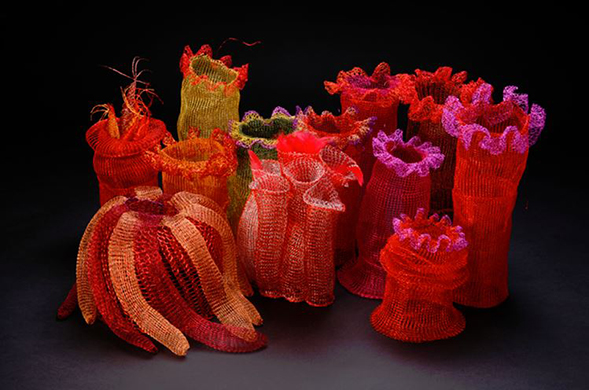Jewel of a Teacher
Artist Arline Fisch leaves SDSU a colorful and multi-faceted legacy.

Arline Fisch’s jewelry art is not for the faint-hearted. Her dramatic silver collars and intricate filigree bibs draw inspiration from ornamental jewelry worn by ancient Greek and Egyptian royalty. They are, in a word, conspicuous.
“I was never really interested in making rings or earrings,” Fisch said in a recent interview with the Art Jewelry Forum. “I wanted to make spectacular jewelry that could be at home in this century.”
Fisch’s theatrical sensibilities influenced not only the craft of jewelry-making in the United States, but also the work of generations of San Diego State University students.
She was hired in 1961 to create a jewelry and metalsmithing program in SDSU’s School of Art and Design (then known as the School of Art, Design and Art History).
Universities across the country established similar programs at the time, but many didn’t survive. SDSU’s program thrived and, under Fisch’s leadership, added a master of fine arts degree. The MFA in jewelry and metalsmithing is still among the leading programs of its kind in the nation.
A lasting gift
Fisch retired in 2000 but her legacy continues through former students who have become artists, gallery owners and university professors. She recently established an endowment for future Aztecs with ambitions to follow in her footsteps.
The Arline Fisch Jewelry and Metalsmithing Endowed Scholarship will support students pursuing a master of fine arts degree in the program.
“SDSU was my life for 40 years,” she said. “It was a good place for me to have the freedom to teach and be an artist at the same time.”
Weaving with gold
Fisch was the first artist to combine jewelry-making and weaving into a unique art form. She learned metalsmithing from the accomplished silversmith, Arthur Pulos, and worked in his studio during her graduate studies at the University of Illinois. Later, as a young teacher at Skidmore College, Fisch taught classes in weaving.
The idea of marrying two very different crafts first occurred to Fisch during a visit to Central and South America, where she saw pre-Columbian textiles embellished with gold and metallic pieces. But it would be another decade before the concept came to fruition in her collection of woven gold items. That collection was shown in London, Vienna and California.
The appeal of traditional artifacts—such as Viking jewelry and Mongolian hats—grew stronger as Fisch continued to travel internationally. She received four Fulbright grants, allowing her to study in Denmark, and teach in Uruguay and Austria. Fisch also became a board member of the World Craft Council, an organization of UNESCO.
SDSU students have reaped the benefits of Fisch’s global network; she hosted dozens of internationally recognized artists who visited San Diego to lecture and work with her students.
“It’s important for students to be taught by professionally active artists,” she said.
A sea of color
Throughout her teaching career, Fisch continued to develop the textile techniques that brought her international fame. In 2006, she was commissioned by the Racine Art Museum in Wisconsin to create an exhibition for its five street windows.
The result was “Sea Creatures,” a riotously colorful collection of jellyfish knit from thin wire. Later, she added coral-like shapes, and the exhibition toured for nearly four years before being purchased by the Mingei International Museum in San Diego’s Balboa Park.
The Victoria & Albert Museum in London, the National Gallery of Australia, the Renwick Gallery in Washington, D.C. and the Cooper-Hewitt, Smithsonian Design Museum in New York also have works by Fisch in their collections.
She has received the American Craft Council Gold Medal and a Lifetime Achievement Award from the National Museum of Women in the Arts.
Fisch’s “Textile Techniques in Metal,” published in 1975, is considered the seminal book on textiles and metal construction.
Arline Fisch's Jewelry Art Arline Fisch, the first artist to combine jewelry-making and weaving into a unique art form, established the jewelry and metalsmithing program for SDSU's School of Art, Design and Art History. All photos are courtesy of Arline Fisch.



